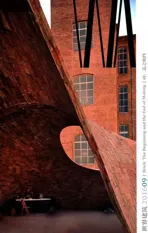道伊斯与贝拉尔德文化中心,马德里,西班牙
2016-10-19建筑设计拉斐尔德拉奥斯建筑师事务所
建筑设计:拉斐尔·德拉-奥斯建筑师事务所
Architects: Rafael de La-Hoz Arquitectos
道伊斯与贝拉尔德文化中心,马德里,西班牙
Daoíz y Velarde Cultural Center, Madrid, Spain, 2013
建筑设计:拉斐尔·德拉-奥斯建筑师事务所
Architects: Rafael de La-Hoz Arquitectos
文化中心项目的核心在于对旧军事兵营的改造,这些营房是前La Maestranza炮兵营区的一部分,其中也包含了道伊斯和贝拉尔德的营房。
设计希望尊重原有建筑的基本几何关系,新的结构系统将老建筑中现存的桁架与金属柱解放出来,将老建筑内部清空并完成了其他新增室内空间的营造。
梯形的平面布局、建筑外部使用的砖墙立面与锯齿形金属表皮屋面的工业结构被完整保留。在此基础上增加的高科技屋面,提供了充足的自然采光与通风,创造了良好的室内微气候。
建筑旧有内部空间被清空,并通过一个中介空间一分为二。一个新的混凝土体量贯穿了不同的楼层,并新增了两层地下空间。一个加建体块自屋顶穿出,如同高悬的灯笼,实际上它将成为为小剧场服务的舞台盒。
建筑内部包含了文化中心的两个主要大厅,及其相关活动的附属空间。一个有顶的集会空间,是容纳聚集、问讯和展览等活动的场所,将室外广场的空间感受延伸至建筑室内。这个文化综合体因此将与其外部的公共空间紧密联系起来。
新旧建筑之间的中介空间分隔,将承载多种用途:(1)突出修复更新后老建筑的原有结构。(2)将这一空间作为缓冲区,即服务于文化综合体的自然过渡与保护性空间,从而获得更高的能源效率。(3)优化两座大厅的空间距离,并为来访者提供更为便捷的到达路径。
建筑使用的材料为:(1)原有墙体中的砖砌块。对旧建筑墙体进行了彻底的修复处理,使其重现原初面貌。(2)层压钢板与夹胶玻璃,用于门窗制造。(3)钢筋混凝土,作为基础材料使用在新增内部建筑体量的结构中。(4)金属锌版,用于屋顶及舞台盒空间。
在这个文化中心的建筑项目当中,建筑师希望寻求的是新与旧之间的中庸之道。概念上来说,它的目的在于尊重现有建筑的精髓部分,以对空间和光作为主体的改造手法,竭力将对这部分建筑的干预和改动最小化。 (陈茜 译)

1 外景/Exterior view
项目信息/Credits and data
客户/Client: 马德里市政厅艺术管理局/Madrid City Council, Government Area of Arts
建筑用途/Building's Purpuse: 文化中心/Cultural Center
建筑面积/Usable Floor Area: 6850m2
地上建筑面积/Floor Area above ground: 3063m2
砖材类型/Brick Type: 粘土砖,饰面砖/Clay blocks, facing bricks
建筑材料造价/Material Cost: $12,839,715.98(含税/ including VAT)
建造周期/Construction Period: 2007.01 – 2013.10
摄影/Photos: Alfonso Quiroga
The project consists in refurbishing old military barracks which were part of the former artillery quartering of La Maestranza including the barracks of Daoíz y Velarde.
Designed with the aim of respecting the basic geometry of the building, the construction system enables the existing truss as well as the metal pillars of the building to remain suspended in the air while it is emptied and the rest of the interior of the building is completed.
The trapeizodal floor plan, the existing brick-built facades and the industrial structure of metal profiles of the saw-tooth roof of the building's envelope have been respected. A high-tech roof has been developed to take the best advantage of natural light and ventilation and to create a microclimate inside.
The interior of the building has been emptied and separated by an intermediate space. A new concrete building is divided into different levels, with two added basement plan floors. An additional volume reaches out from the roof, like a lantern. This new volume will become a stage box for a small theatre.
The inside building contains two main halls at the center and all necessary annexes to develop activities derived from it. A place for meeting,information and exhibitions, which works as a covered agora, as if the square outside extended into the building. The complex will thus be interrelated with the exterior public spaces.
The intermediate separation between the former and the new building has been maintained for different purposes: (1) Highlighting the original structure of the refurbished former building. (2)Using this space as a buffer zone, a natural filter and protection of the cultural complex, thus obtaining greater energy efficiency and (3) Optimizing the distance between halls and providing an easier access to the visitors.
The materials of the building are: (1) Bricks on the walls. Thorough treatment has been performed to restore the original appearance of its walls. (2) Laminated steel and laminated glass for the carpentry of doors and windows. (3)Reinforced concrete, used as a base material for the construction of the new interior building. (4) Metal panels of zinc for the roof and the stage box.
The architecture project of the Cultural Center is halfway between the new and the existing. Conceptually, it aims at respecting the essence of the building, which implies a minimum intervention where space and light play the most important part.

2 改造后的立面/View of the old building and the new theater hall3 首层平面/Floor 0 plan

4 内景/Interior view

5 竖向交通示意/Schematic diagram of staircase
评论
王丽方:一清二楚地保留,干净利落地加建,很理性。舞台盒子与锯齿形屋顶造型交织简练可看。室内水泥基地坪选材适当。由于凸显了顶部的轻盈,砖建筑的整体感被消除。而在局部,由于简单地清空室内,砖墙的转角、壁柱、剪力墙等处可望表达敦厚的体量感,这样的机会也被放弃了。留下来的砖墙,看起来单薄可怜。新旧建筑之间没有能产生令人兴奋的反差与张力。空间直通,平淡无奇。砖建筑内部最应有离奇的空间。既然有观演功能,至少应该可以做一个高大空间,阶梯式地深深地探入砖建筑体量的深处,打破高度上的均一化。用光是大平光。锯齿形屋顶采光,用于兵营或许不错,用于文化中心就缺乏文化意味。老旧的砖建筑室内光环境的特点是富于变化,用于文化中心会很动人。砖建筑被简单地视为砖表面了。
Comments
WANG Lifang: It is rational to clearly keep and tidily extend the buildings. You can find the succinct interlacing of the stage box and the zigzag-shaped roof.The selection of material for the indoor cement base is appropriate.
Due to the lightness of the top, the overall impression of the brick building is eliminated. In local sector, the merely emptiness of indoor room has expelled the solid sense of uniformity that the corners,pilasters and shear wall might express. The remained brick wall looks thin. Between the old and new buildings,there is no exciting point of contrast and tension.
There shall be bizarre space inside the brick buildings, for it is too simple to direct connect spaces. Considering the function of viewing performance,there shall at least be a huge room penetrating the depth of the brick building step by step, so as to break the homogenization of the height.
Equally distributed light is applied in the building. The lighting of the zigzag-shaped roof might be more suitable for barracks, but lack of cultural meaning for cultural center. The interior light environment of the old brick building is characterized by the changeable lighting,which will be attractive when used in the cultural center.
The brick building is simply viewed as the brick surface.
郭海鞍:作为一个改造项目,道伊斯与贝拉尔德文化中心完美地体现了新与旧的对比,建筑外观基本上保持了原来的外貌,保持街区记忆。为了应对老墙的保护,设计师在建构上采取了两个非常明智的选择。首先是旧砖墙基础混凝土加固和新建部分混凝土基座的结合,浑然一体,自然过渡。其次是顶部旧墙悬臂端和新建部分钢结构桁架的结合,两种原真材料轻盈地衔接,逻辑十分清晰。这种对结构形式和建构逻辑清晰的判断值得我们在旧建筑改造设计中认真地思量与学习。
GUO Hai'an: As a renovation project, the Daoíz y Velarde Cultural Center shows a clear contrast between the old construction and the new addition. The building retains its original exterior appearance, which retains the memory of the old streets. To preserve the existing brick all, two wise choices were taken. One was the choice of concrete as chief material in both the basement of the new addition and the foundation reinforcement of the old brick wall, so that the two parts form a seamless transition. The other choice was the logical selection of the steel truss structure,complementing the brickwork and lightly connecting to the old wall. The exact design decisions made here are quite important, and should be studied and considered as a case study for similar renovations of old buildings in China.




6 内景/Interior view7.8 新旧建筑语言的对比/Contrast between two distinct architectural languages9 纵剖面/Longitudinal section10 东立面/East elevation11 西立面/West elevation12 北立面/North elevation
